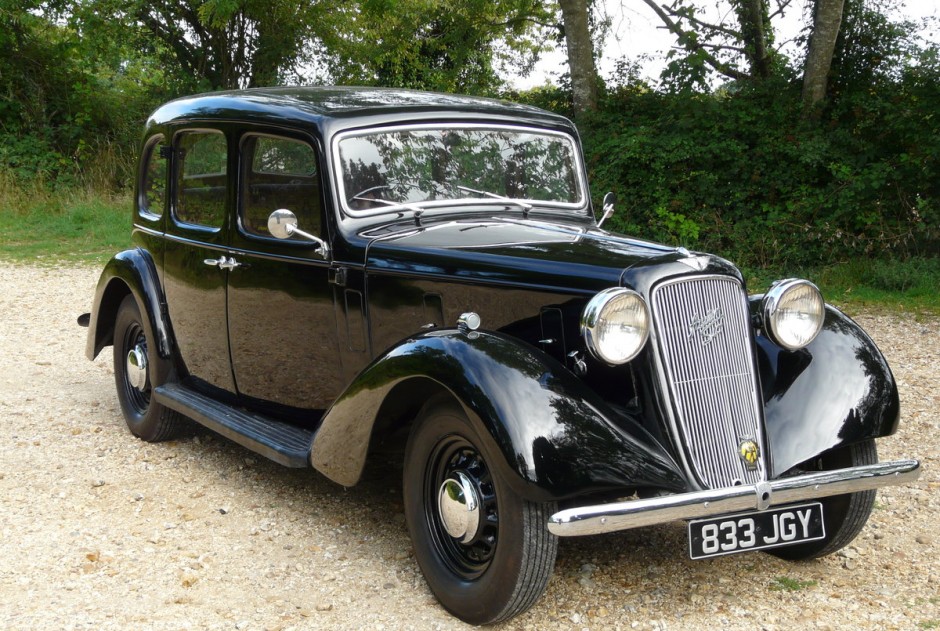AUSTIN GOODWOOD 14/6 SALOON
HOURS OF OPENING Monday – Saturday 00.00am – 24.00pm Sunday 00.00am – 24.00pm
 |
 |
 |
 |
The Austin Motor Company introduced the 14hp Goodwood Saloon as part of new Programme for 1937.
Fourteen Goodwood Saloon
In August 1936, the Austin Motor Company introduced the 14hp Goodwood Saloon as part of the “New Programme” models available from 1937; the other Austins were the 10hp Cambridge and the 12hp New Ascot.The Goodwood used an all-steel body, with sweeping lines, creating generous seating and interior dimensions. The car was fitted with a steel flush-fitting sliding-head, and a pressed steel bulkhead. All the panels, including those of the floor and roof, were damped with sound insulating material to ensure maximum quietness.
The front seats were adjustable, and to provide the ideal driving position, the steering wheel was also adjustable for reach, over a range of 3 inches. In the tail of the body there was room for a spare wheel and a fitted suitcase. A rear panel/boot lid could be dropped to the horizontal position to form another platform for additional luggage.Open boot sowing ample luggage space.
In 1938 the Goodwood Saloon was changed with a longer bonnet, wider and higher doors. It was fitted with the Borg and Beck clutch. Later in 1939 over-riders were added to the bumpers.
The car was promoted by Austin as a fast, reliable saloon capable of carrying four people in comfort, or even five people when the rear centre arm-rest was folded back into the upright position.
Engine:
6 cyl. side-valve, with detachable head, 1,711cc 15.96hp RAC rating with 69.5mm bore and 84.6mm stroke. Later block castings had 14 on the side. It had a four-bearing crankshaft, down-draught Zenith 30VM2 carburettor, coil ignition, aluminium-alloy pistons, and used thermo-syphon and fan cooling. The engine had rubber three-point mountings; the exhaust also used rubber mountings to absorb vibration. Later block castings had 14 on the side. During 1938 the Goodwood was fitted with an uprated “high compression” engine, developing a claimed 52bhp @ 4200rpm, compared with the earlier engine which had 38.7 bhp @ 3,800rpm. This later improved engine had larger inlet valves and used a Zenith 36 VE1 carburettor. A pressure gear pump forced oil to all main, big-end and camshaft bearings.
Transmission:
single plate clutch, 4 speed gear-box with synchromesh on 2nd, 3rd and 4th gears. The car was fitted with a Hardy-Spicer propeller shaft, ¾ floating back axle with spiral-bevel drive.
Brakes:
Girling brakes on all four wheels which were operated by the foot pedal and handbrake. Braking from 30mph to stop took 31ft 6in with a braking efficiency of 97%. The later model in 1939 was produced with a new pistol grip handbrake.
Steering:
“Hour-glass” worm and sector
Suspension:
semi-elliptic springs mounted on Silentbloc bushes, fitted to the front and rear, with hydraulic double-acting piston-type Luvax shock-absorbers. The springs have zinc interleaves and oilite discs to maintain suppleness
Wheels and tyres: easy-clean pressed steel spoke with large centres, with 5.75-16 low pressure Dunlops. Special jacking pads were fitted on the rear springs.
Equipment:
12-volt electric lighting, with 2 x 6v batteries fitted under the front seats. There was a foot operated switch for dip/main beam, dual stop and tail lamps, illuminated instruments and automatic return direction indicators, two windscreen wipers mounted on the scuttle. The rear passengers had the use of flush fitting foot rest, and window blinds. A parcel net in the roof was a real luxury for the saloons but was not part of the Cabriolet. The windscreen could be opened using a winder fitted to the dashboard.
Performance: The 14hp Goodwood Saloon could cruise at 55mph, and for short periods of time it was claimed that the car could achieve 65mph or even 70mph. On one occasion a distance of 160 miles travelling along the Great North Road was completed in 3 hours 40 minutes, including one stop for refuelling. This equates to an average speed of 44mph. During a road test of over 500 miles, petrol consumption was 26.5 mpg even at relatively high speeds. Acceleration from 0 – 30mph was possible in 6 secs, using 2nd gear. From a standstill to 50mph took 20 secs using 2nd, 3rd and 4th grears.
Wheelbase:
9 ft 3 ¾ ins
Track: Front – 4 ft 3ins, rear 4 ft 5 ½ ins
Chassis: The car was built on a welded chassis of full length, with deep side members, cross members and cruciform centre members.
Costs: In 1939 the Goodwood 14hp Saloon with a sliding-roof cost £245, whilst the fixed head saloon sold for £235. The most expensive Goodwood was the Cabriolet model for sale at £252. This had a roof which could quickly and easily be folded back, but was otherwise very similar to the saloon.
There was a wide selection of colours in the Goodwood range, each with upholstery to match, although not every combination was offered with the Fixed Head Saloon or the Cabriolet models:
Colour Rang
Royal Blue body with Black Wings Princess Blue with Blue Wings Maroon with Black Wings Bluebird Blue with Blue Wings Ash Grey with Grey Wings Pueblo Brown with Malay Brown Wings Black with Black Wings
The Goodwood FR Saloon commenced with chassis No. F29,535. The earliest vehicle known to the club is F29,538 registered on 13th August 1936 as COG 710
The Goodwood FRA Saloon commenced with chassis No. 39,592. The earliest vehicle known to the club is F39,191 registered on 31st December 1938 as EYH 302. The latest known vehicle in this group is F42,264 registered on 25th April 1939 as CSG 210.
.
